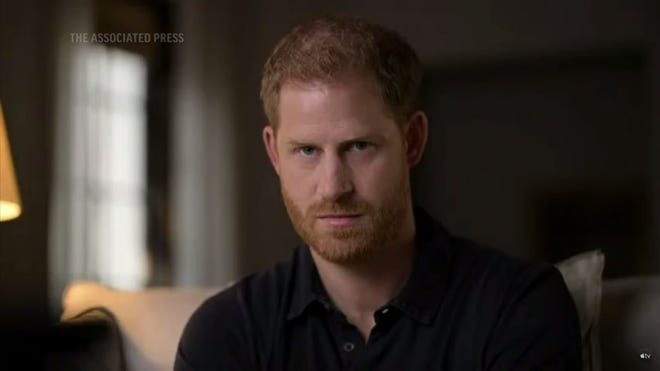
Prince Harry, whose mother Princess Diana died violently and suddenly when he was 12 years old, has in the last several years shared intimately about the mental health impacts of his trauma and how therapy helped him address his suffering. In his new Apple TV+ docuseries on mental health with Oprah Winfrey airing Friday, Harry shares his experience with a specific therapy he found especially effective: EMDR.
Eye movement desensitization and reprocessing (EMDR) was developed by psychologist Francine Shapiro in the 1980s to help people alleviate distress around painful memories. The therapy has been used by clinicians for decades, but has become an increasingly popular and sought-after treatment to deal with traumatic or adverse life experiences.
In the docuseries, Harry shows viewers the experience of using EMDR to address the discomfort he feels when he flies into London, which he said reminds him of the loss of his mother. Harry says he feels nervous, tense and hollowed out. He thinks of being "hunted," "helpless" and as though "there is no escape."
'The Me You Can't See':Prince Harry, Lady Gaga and Oprah drop emotional revelations
During the session, as the clinician encourages him to follow the memory, the sensations, the negative feelings, Harry is seen tapping alternately on each shoulder. The clinician continues to asks question about the texture of the memory, and eventually asks what he would rather feel instead. As the treatment progresses, Harry says he moves to a place of "calmness" and "strength."
"It's almost a wave that can't be stopped because people are hearing their friends talk about it, they're seeing the changes in their family members," said Wendy Byrd, a professional counselor and president of the board of directors at the EMDR International Association. "When I was trained in 2008, I would have to go in and explain what EMDR was and tell my clients why I thought it was such a good therapy. ... Now, I would say almost everyone that comes into my door is asking me for EMDR."
Analysis:Some people don't believe Meghan was suicidal, and that can be so dangerous

Harry, who said addressing his trauma was essential both for his own well-being and the health of his relationship with his wife the Duchess of Sussex, said he experimented with EMDR after years of traditional behavioral therapy.
"One of the biggest lessons that I've ever learned in life is you've sometimes got to go back and to deal with really uncomfortable situations and be able to process it in order to be able to heal," he said.
USA TODAY spoke with Byrd on how EMDR works and who it helps.
What is EMDR?
EMDR engages what’s called the adaptive information processing system to bring up past traumatic experiences in a safe space, so your brain can essentially re-process them.
"EMDR allows the brain to heal from experiences that were traumatic or adverse or overwhelming by allowing the brain to process that information and to store it in a way where the brain now knows, 'I'm in a different circumstance, that's not happening to me anymore,'" Byrd said.
Our brains and bodies have a built-in mechanism for processing information. But sometimes, especially when we experience a trauma, that mechanism becomes overwhelmed.
When new information comes in that feels similar to that adverse experience, the brain stores it in the same place as the original trauma, Byrd said. This can make things in your everyday life that are not threatening feel dangerous.
"It's the blue car driving down the road, or it's the dog barking, or your spouse's face in that one contorted way, and all of a sudden, you're upset, you're triggered and overwhelmed," she said.
How does a clinician conduct EMDR?
Byrd said in an EMDR session a clinician will ask questions to bring up the components of a memory, including sensory information – such as sight, sound, and smell. A clinician will ask how your body felt during the experience, how you felt during the experience – the emotional information that connects to that memory.
Eventually, the clinician will add in eye movements or tapping. This is called bilateral stimulation. Studies show that eye movements facilitate information processing and calm down a person's physiology.
"It will make something that feels upsetting, less upsetting. It helps the brain make images that are very vivid, less vivid. And part of that is because of what we call dual attention, meaning I'm present in the room with the therapist, or over Zoom, nowadays, and I'm thinking about that experience and it's all the ingredients that the brain needs to engage that adaptive information processing mechanism."
Part of the re-processing occurs by the clinician introducing positive things into the recall. A therapist will ask, "What do you want to think now about that experience?"
"It brings in the current information. Maybe the positive is that it's over, or maybe it's that you learned from it or that now you now you're worthy," she said.
What is the most effective stimulus during EMDR?
In the docuseries, Harry uses tapping as his stimuli. Byrd said while eye movements are the most researched, other stimuli are proven to be effective.
"It really becomes the client's preference," she said. "Some people can't really tolerate eye movements for different reasons, or they may have something that's going on where we choose a different stimulation."
Who is a good candidate for EMDR?
Byrd said EMDR works on various types of trauma, and most people are good candidates for the treatment. EMDR can be effective whether someone is seeking to address a single traumatic event, such as a car crash, or a chronic experience, such as bullying.
Viewers learn through Harry's clinician that he has three or four memories that are particularly distressing. Byrd said a person in a full treatment plan with EMDR may have several memories they want to target, but she's also treated patients who have only one experience they want to address.
More:Prince Harry said he turned alcohol and drugs to cope with a 'nightmare' time in his life
Does EMDR work on children?
EMDR is effective for children, and Byrd said addressing trauma early is always preferable.
"What we know about adversity is it sits on the body and causes harm, and later in life can cause things like chronic illness or chronic pain or mental health disorders," she said. "The earlier and sooner we can take care of a trauma and get it off of the nervous system, get it processed, the better the health of the whole person is."
How long before EMDR is effective?
Byrd said EMDR can be effective after one session, though to get the most benefit people generally engage longer. Byrd had a client who was in a serious car accident who was able to complete treatment in three 90 minute sessions. Other clients have stayed in treatment for six months or longer.
"It really depends on what the person brings in and how their life experiences have shaped what's going on," she said.
Does EMDR work over Zoom?
At the start of the pandemic Byrd worried EMDR wouldn't be as effective during video conferencing. But she was relieved to learn it worked well even when a client and their patient weren't in the same physical space. There are computer programs that help clinicians stimulate bilateral stimulation and eye movement.
"Obviously there's going to be the exceptions where you want to see people in person because of the acuity of what they're dealing with, but the last year has taught most of us that EMDR can be done remotely very well," she said.
What is the hope for a patient after they complete EMDR?
Patients work with their clinicians to identify future outcomes they desire – how they want to think, feel and behave in the world. For Byrd's part, she's looking to build resilience.
"I want their triggers to be very difficult to find," she said.
Byrd encourages anyone with a painful memory to consider EMDR.
"People feel like sometimes what happened to them isn't big enough. They should just be able to get over it. ... And that just breaks my heart because I know that they can feel better and that they do deserve to feel better," she said. "I just wish that people knew that they could come in, we could figure out some of the things that are happening that are causing them pain, and that it would be not that long of a journey before they could get some relief."
EMDR resources you may be interested in:
Source link









